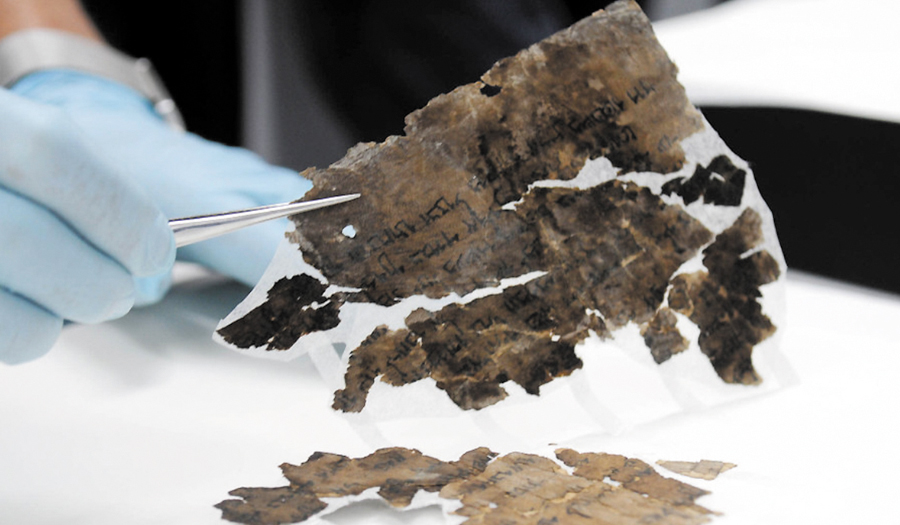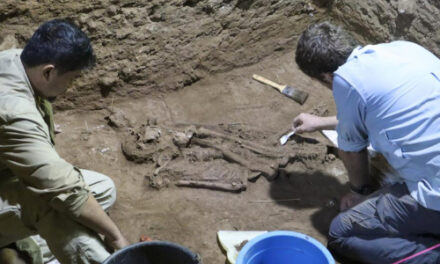By Ilan Ben Zion, Associated Press
Jerusalem (AP) – A fragment of an enigmatic Dead Sea Scroll has gone on public display at Jerusalem’s Israel Museum for the first time since its discovery 70 years ago.
The Genesis Apocryphon, the sole copy of an ancient Jewish text elaborating on stories from the first book of the Bible, dates to the first century B.C. and was among the first seven scrolls found in the Judean Desert in 1947. The Associated Press previewed the exhibit Tuesday.
The Dead Sea Scrolls, a collection of Jewish texts found in desert caves in the West Bank near Qumran in the 1940s and 1950s, date from the third century B.C. to the first century A.D. They include the earliest known copies of biblical texts, documents outlining the beliefs of a little understood Jewish sect, as well as related texts like the Genesis Apocryphon.
“This is the only copy of this book on Earth,’’ said Adolfo Roitman, curator of the Israel Museum’s Shrine of the Book, where the scrolls are housed.
The Genesis Apocryphon’s Aramaic verses describe the lives of Noah, Abraham, Enoch and Lamech, characters in the book of Genesis, and are written in the first person. “In some way what we have are parallel stories that we don’t have in the Hebrew Bible in which the patriarchs are presented in different ways than the ways we have today in the Pentateuch,’’ he said.
The badly damaged snippet of the story going on display deals with Noah’s Ark alighting on the peaks of Mount Ararat after the fabled flood. Noah tells how he “atoned for all the earth in its entirety’’ by offering up various animal sacrifices.
The Genesis Apocryphon scroll was already in a precarious state when it was first discovered by Bedouin shepherds in 1947.
A rare recording of the shepherds, Muhammed edh-Dhib and Jum’a Muhammed, recounting their discovery is part of an accompanying exhibit about some of the characters involved in finding and unlocking the Dead Sea Scrolls.
“It was dark at first, but when I could see before me, there were about 10 jars in the cave on both sides, and the jars in the middle were broken by some ruins falling from the top,’’ edh-Dhib, speaking in Arabic, says in a 1961 interview. “There were three manuscripts in one covered jar only. Two of them were rolled in cloth and the other was not. And their color was greenish.’’
The fragile Genesis Apocryphon manuscript remained unrolled until nearly a decade later, by which point it had been brought to New York, purchased by the State of Israel along with three other scrolls, and returned to Jerusalem.
Since then, only one section of the Genesis Apocryphon went on a brief public exhibition in the 1960s.
“It’s the first time the general public is seeing it,’’ said Israel Museum director Ido Bruno. “We have a window of opportunity today to see it for a few months and then it will go back to the cellars and will not see the light of day again for dozens of years.’’
To protect the delicate parchment, the fragment is presented in a special “smart glass’’ vitrine inside the Shrine of the Book that prevents it from exposure to direct light. When visitors press a button, the opaque white glass becomes clear for 30 seconds, allowing viewers to study the ragged brown scrap before it is once again obscured.
“When you take a look at this manuscript, it’s not like taking a look at Botticelli,’’ Roitman, the exhibit curator said. “It doesn’t look very aesthetic, that’s not the point. The point is actually the kind of information in this document, as a lost tradition, that we didn’t know about before. It opens up a new perspective on ancient Jewish history and civilization.’’
Image: Some of the Scrolls in Jerusalem









